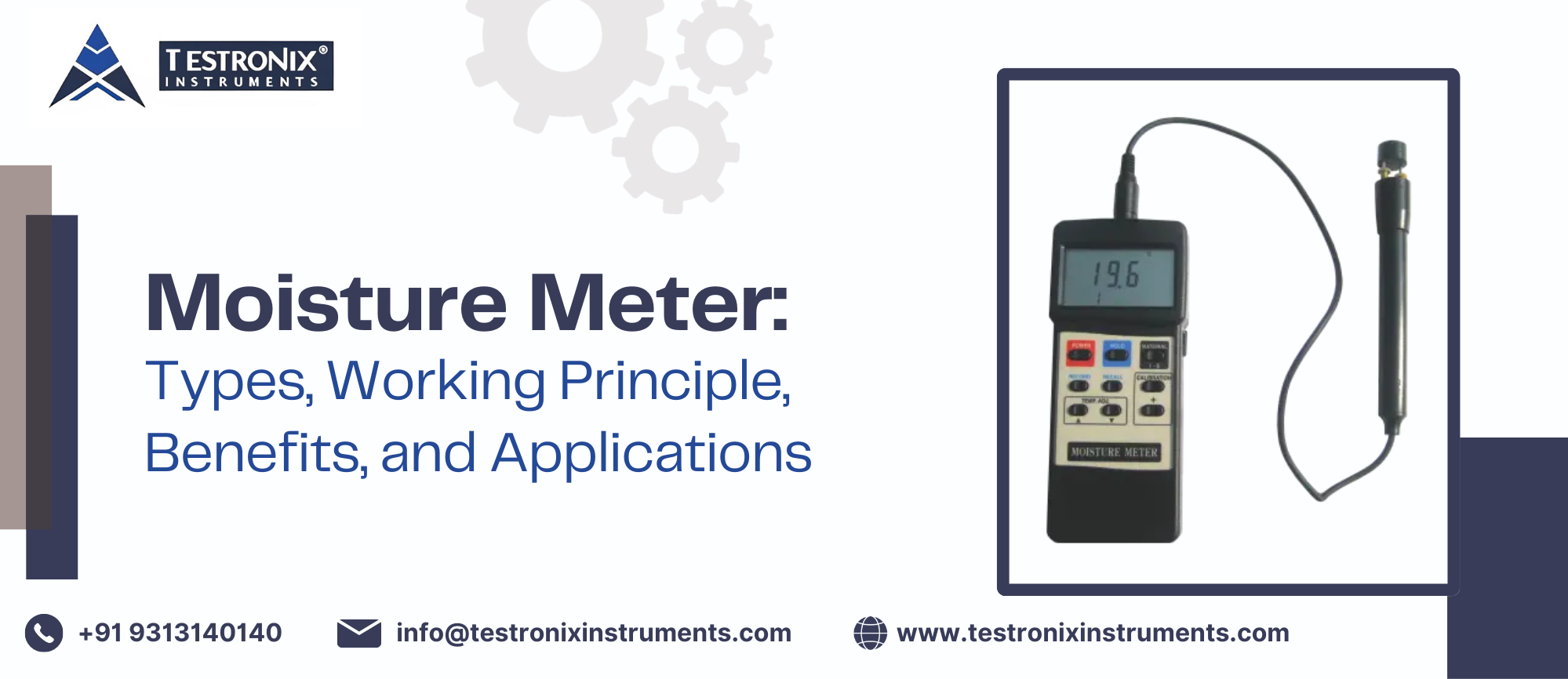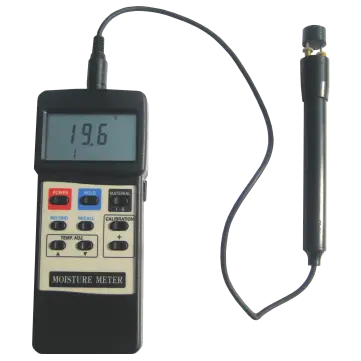Reviewed by Anurag Mishra (Sr. Technical Consultant)

Moisture plays a major role in multiple industries, moisture impacts the quality, durability, and usability of materials. Understanding moisture in materials is important for maintaining standards and avoiding costly issues like mold or structural damage.
In this guide, we will discuss everything you need to know about a moisture meter. We cover what is moisture meter, the types of moisture meters, the working principle of a moisture meter, and how to use a moisture meter.

A moisture meter is a device that is used to measure the moisture content in a material. By detecting moisture content in materials, moisture meters help prevent situations like rot, decay, and mold growth in materials.
Moisture meters are used in industries such as paper and textile, construction, agriculture, and more to make sure materials match the required standards for moisture level.
Moisture content in materials is usually presented as a percentage (%), It shows the weight of water in a material compared to its total weight. This data is important for quality control and maintaining the strength of the material.
A digital moisture meter is a modern electronic device; it is an advanced version of a traditional moisture meter. Digital moisture meters have enhanced accuracy, are convenient, and are easy to use. Using advanced features, it displays readings on an LCD or LED screen.
These devices are widely used in industries where accurate moisture measurements are required. These digital devices are equipped with features like:
provide readings in percentage (%) or specific units like grams per kilogram (g/kg) or pounds per cubic foot (lb/ft³), depending on the application. The choice of unit ensures precise monitoring, helping industries like agriculture, construction, and manufacturing maintain quality and prevent damage caused by excess moisture.
However, due to their multiple applications, moisture meters use multiple units to determine the moisture in the materials. Here are all the units in which moisture is measured:
Percentage (%) is the most common SI unit to measure moisture in materials. It shows the amount of water in the material as a percentage of its dry weight.
WME is the unit to determine the moisture content of non-wood materials as if the material is made of wood. The WVM value is used to measure the moisture levels of different materials using a single unit.
The RH unit is used to measure the amount of water vapor in the air within a material, determined as a percentage. Relative humidity is used in materials like concrete.
It measures the exact amount of water content in a volume of air and materials. This unit is frequently used in moisture analysis of soil or air in industry procedures.
Some pinless moisture meters give readings based on the dielectric constant of the material.
The moisture meter translates this into a relative scale or percentage for easy interpretation.
Moisture meters come in different types, each used for a specific purpose and can be differentiated via their working and usage. There are 3 main types of moisture meters which are:
Pin-type moisture meters use 2 metal pins to measure electrical resistance by inserting these pins into the materials. Electrical resistance changes based on the moisture content of materials. For precise readings in small, local areas, pin-type moisture mentors are used. These meters are invasive and make holes in the material.
Pinless moisture meters use sensor plates to measure moisture levels through electromagnetic waves. Sensor plates rest against the surface of the materials. These devices are non-invasive and best for measuring moisture across larger areas.
Gravimetric moisture meters detect moisture content by weighing a sample and weighing it again after completely drying it. The weight difference before and after drying gives accurate moisture content.
Other than these 3 major types, moisture meters have more types based on their usage in multiple industries. Here are some other types of moisture meters:
Infrared moisture meters utilize infrared radiation to measure moisture content in materials non-invasively. These moisture meters work by analyzing both the absorption and reflection of infrared light. This data can vary based on the material’s moisture level. Infrared moisture meters are ideal in large areas, like walls or floors.
Rapid moisture meters give reliable readings within seconds. These moisture meters are commonly used in agriculture and food processing industries. They use pressure or chemical reactions to determine moisture content in materials.
Soil moisture meters are used to measure moisture levels in the soil. Soil moisture meters are widely used in agriculture, gardening, and environmental research to ensure the best conditions for plant growth. Some specific models of moisture meters can also measure soil pH and temperature analysis.
A paddy moisture meter is used in the rice industry to measure the moisture content of paddy rice. They help in determining whether the paddy rice is ready to store or process to prevent quality degradation.
Rice moisture meters are similar to paddy moisture meters, These moisture meters are used to measure the moisture content of processed rice. These devices make sure the rice meets quality standards for consumption or storage.
The moisture meter working principle is based on the interaction of material and sensor mechanism. Here is the moisture meter working principle:
Here we break down the process of using a moisture meter. Here’s how you can use a moisture meter:
Make sure the material is clean. Sometimes dirt and oil can interfere with accurate readings.
Choose the material type on the moisture meter.
Moisture will be displayed in the form of a percentage (%). Ideal percentage levels can vary based on the type of material.
Take multiple readings to identify variations in the moisture of the material.
Moisture meters are used to measure and detect moisture in different types of materials to ensure material quality, safety, and efficiency in various applications. The accurate details of moisture help to make the right decisions and avoid issues caused by improper moisture levels.
Applications of moisture meters are diverse and essential in multiple industries like construction, agriculture, wood, food, and the paper industry. Here is how these industries use moisture meters:
Moisture meters are essential in multiple industries to detect accurate data of moisture in a material. Here are some benefits of using a moisture meter:
Moisture meters have some minor limitations with them. Here are some limitations of moisture meters:
The concept of a moisture meter is to determine the moisture in a material. It shows the amount of moisture content present in a material. Usually, it shows moisture data in percentage, it is helpful in multiple industries to prevent issues like quality degradation of materials.
Yes, moisture meters are precisely accurate. Digital moisture meters have a precision range of between 1% and 2%. With proper calibration and the right moisture meter according to the type of material, moisture meters can give highly accurate readings.
The principle of moisture meter is to evaluate the moisture content present in a material. However, different types of moisture meters have different working principles, such as:
Moisture meter for paddy is called a paddy moisture meter. These devices are widely used in the agriculture industry to measure the moisture content in paddy rice. They help in detecting whether the paddy is ready to store or process.
A moisture meter for corrugated boxes measures the moisture content present in the cardboard material. It ensures the structural strength and prevents issues like wrapping or softening of material.
Moisture meters cannot directly detect leaks, but some meters, like pinless moisture meters, can identify areas with high moisture levels. They can be used in large areas like walls and floors to detect problem spots.
To read a moisture meter, make sure the material surface is clean. Place the meter on the surface of the material, and it will show the reading on the display. Take multiple readings for a precise value of moisture content.
These two moisture meters are different from each other, Here’s the difference between Pin-type and Pinless moisture meters:
A moisture meter is essential in industries where precise moisture content is critical to detect and maintain the quality of materials. Here is why you need a moisture meter: